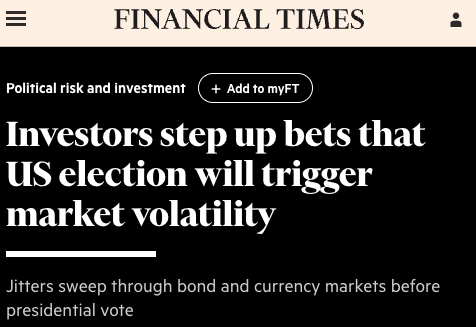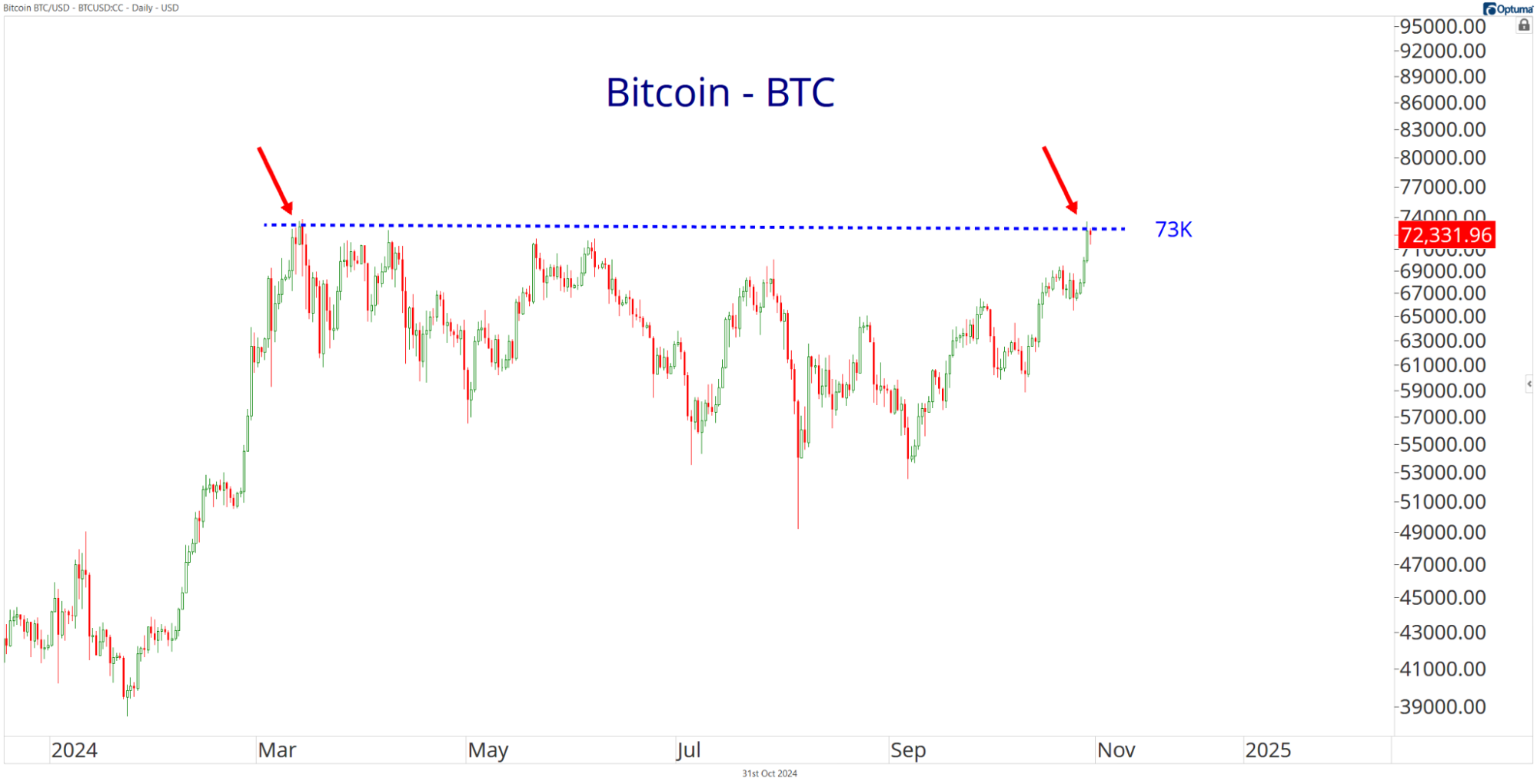The Endless Vote Count
![]() Wall Street Recalibrates Its Election Bets
Wall Street Recalibrates Its Election Bets
 Wait a minute, I thought the mainstream narrative was that markets were already pricing in a Trump victory.
Wait a minute, I thought the mainstream narrative was that markets were already pricing in a Trump victory.
That’s what all the headlines of recent days were saying…
- “U.S. Dollar Surges as FX Markets Bet on Trump Win, Tariffs” (Yahoo Finance)
- “European Stocks Hit by ‘Trump Effect’ as Odds Tilt Toward Republican Win” (Financial Times)
- “Billionaire Investor Says Market Is ‘Very Convinced’ of Trump Victory” (The Hill).
(We won’t leave you in suspense. The billionaire investor in question is Stanley Druckenmiller.)
Anyway, that was then, this is now…

“Investors have been raising their bets that next week’s U.S. presidential election will trigger sharp price swings in bond and currency markets,” says the Financial Times.
“Benchmarks that measure potential volatility over the next 30 days in foreign exchange and equity markets have also risen ahead of Tuesday’s vote, as polls indicate a very tight race between Republican nominee Donald Trump and Democratic candidate Kamala Harris.”
The salmon-colored rag points to the MOVE index — a measure of volatility in the bond market similar to the VIX in the stock market. This morning it sits at a year-to-date high at 135.
➢ Note well: Anytime the MOVE index surpasses 140, it typically signals some sort of imminent dislocation in financial markets — most recently, the regional bank failures in early 2023. Yes, we’ll be watching this one closely in the days ahead.
![]() Why Does the Counting Take So Long?
Why Does the Counting Take So Long?
 But why the sudden jitters on Wall Street after two or three weeks of certainty that Trump would win?
But why the sudden jitters on Wall Street after two or three weeks of certainty that Trump would win?
Maybe it’s the realization that even if Trump wins, it will only be after days or perhaps weeks of uncertainty.
Elsewhere in today’s FT we’re told that “U.S. news groups are preparing for an election night that may not result in a clear winner. In 2020, it took four days for the media to declare that Biden had defeated Trump, leaving Americans in suspense as they waited for votes to be counted in Pennsylvania.”
An abundance of caution? Or “predictive programming”?
We’re reminded of a “democracy in danger” speech Joe Biden gave shortly before the midterms two years ago: “In some cases we won’t know the winner of the election for a few days — until a few days after the election. It takes time to count all legitimate ballots in a legal and orderly manner. It’s always been important for citizens in a democracy to be informed and engaged. Now it’s important for a citizen to be patient as well. That’s how this is supposed to work.”
Which begs the question: It wasn’t always this way. What changed?
 We don’t know the answer. But we do know that in a host of other countries, the results are tallied much faster and with less question about their validity.
We don’t know the answer. But we do know that in a host of other countries, the results are tallied much faster and with less question about their validity.
The civil liberties litigator-turned journalist Glenn Greenwald has spent the last 20 years splitting his time between the United States and Brazil.
In Brazil, “the way every single election works is that the polls open at 8 in the morning and close at 5 in the afternoon or 6 p.m. in the afternoon, depending on the particular state.
“And then by 9 or 10 at night, 10:30 p.m. or 11 p.m. at the absolute latest, the full complete vote count not just for the presidential race but for the governor races, for the state legislatures are all fully counted and certified.”
Greenwald points to other examples…
- France’s elections in July wrapped up at 6:00 p.m. local time. By 12:30 a.m., results were known for all but 10 of the 577 National Assembly seats
- Indonesia holds the world’s biggest one-day election — with 205 million registered voters spread across three time zones and 75% turnout. Early results are known within two hours of the polls closing
- In South Korea’s elections last spring, 99% of the votes were counted by 6:00 a.m. the next morning.
Meanwhile it took nearly two months this spring for California officials to tally the results from a U.S. House primary.
Greenwald: “Is it any wonder, even if the counting is perfectly in good faith, that people have serious doubts about the integrity of the results when days go by and the results keep changing and no one knows where ballots are, and there are ballots over here of one kind and ballots over here from another, and some are destroyed and some get lost and some get disputed?”
![]() Yesterday’s Sell-off Is Yesterday’s News
Yesterday’s Sell-off Is Yesterday’s News
 So much for yesterday’s sell-off: Amid more Magnificent 7 earnings and the monthly job numbers, all the major U.S. stock indexes are up 1% or better.
So much for yesterday’s sell-off: Amid more Magnificent 7 earnings and the monthly job numbers, all the major U.S. stock indexes are up 1% or better.
The earnings this time are a mixed bag: Amazon is up 7% on the day after reporting strong growth on both the top and bottom lines. The company plans to plow tens of billions more into AI but Wall Street is OK with that because CEO Andy Jassy promises AMZN can “monetize” those investments.
On the minus side of the ledger, Apple is down 1.5% on the day. AAPL reported record revenue for the September quarter — but Wall Street analysts were bummed by the outlook for the current quarter.
 Meanwhile the media were already setting the table for a lousy job number before its release this morning — Hurricane Milton and the machinists’ strike at Boeing, they said.
Meanwhile the media were already setting the table for a lousy job number before its release this morning — Hurricane Milton and the machinists’ strike at Boeing, they said.
But no Wall Street economist was expecting a number this weak: The wonks at the Bureau of Labor Statistics conjured a mere 12,000 new jobs for October. As a reminder, it takes at least 150,000 new jobs a month just to keep up with the growth of the working-age population.
While that number can conceivably be chalked up to hurricanes and strikes, this can’t: The September and August numbers were revised down, and not by a little. Thus the average for the last three months is only 104,000 — well off the pace for the first half of the year.
Especially concerning is a drop in temporary positions: When times get tight for a business, temps are among the first to get cut.
The official unemployment rate held steady at 4.1%. It’s been 4% or higher for the last five months. The “U-6” rate — which includes part-timers who want to work full time and people who’ve given up looking for work within the last year — held steady at 7.7%.
 But for Wall Street, the hurricanes-and-strikes explanation is good enough.
But for Wall Street, the hurricanes-and-strikes explanation is good enough.
At last check, the S&P 500 is up 1% on the day. At 5,765 the index sits about 3% below its record close notched two weeks ago today. The Dow and the Nasdaq are both up about 1.3% from yesterday’s closes.
Treasury yields keep rising — the 10-year note now over 4.35% for the first time in nearly four months.
Precious metals are little changed after getting slammed yesterday — gold at $2,746 and silver at $32.71. Crude is back above $70 a barrel.
Bitcoin has slipped below $70,000 but Paradigm chart hound Greg Guenthner says the price action is still constructive.
“Bitcoin quickly attacked resistance at all-time highs earlier this week,” he says in today’s Truth & Trends e-letter. “It’s now consolidating in the $70K range and it’s starting to look like a breakout will materialize any day now…

“I can’t tell you exactly when Bitcoin will smash through those highs and start running again,” he says. “But when it does, the move will probably be a ferocious one.”
One more economic number of note: America’s factory sector is still in the dumps, the ISM manufacturing index clocking in at 46.5. Aside from this past March, this number has spent two years mired below 50 — suggesting a contracting factory sector.
![]() Electric Truck Reality Check
Electric Truck Reality Check
 It appears blue-state lawmakers and regulators are getting a reality check about going green — at least when it comes to electric trucks.
It appears blue-state lawmakers and regulators are getting a reality check about going green — at least when it comes to electric trucks.
California will ban sales of trucks with diesel engines come 2036. But New York, New Jersey, Massachusetts and Oregon are having second thoughts about following California’s lead.
“The state is just not ready,” says New Jersey state Sen. Patrick Diegnan, the chair of the Transportation Committee. Politico reports he’s introducing a bill to delay the start of New Jersey’s own mandate by two years.
The reason? Not enough electric trucks and not enough chargers.
For the moment, Washington state is still on board. But the trucking industry is putting Gov. Jay Inslee on notice.
In an opinion piece published on the industry site FreightWaves, Washington Trucking Associations President Sheri Call warns that “forcing the move before the technology is ready will have much larger implications for our supply chain and trade-dependent economy.
“We need only look to the recent (and brief) East Coast port strike, when shoppers raided store shelves for basic supplies such as toilet paper — shades of the COVID pandemic all over again.”
![]() The McFlurry Kerfuffle Is Over
The McFlurry Kerfuffle Is Over
 And now a follow-up to a tweet that we let speak for itself just over three years ago…
And now a follow-up to a tweet that we let speak for itself just over three years ago…

Because all other problems had been solved at that time, right?
It turns out the problem had nothing to do with negligence on the part of McDonald’s or its franchisees. It had to do instead with… federal law.
Under the Digital Millennium Copyright Act of 1998, it is illegal for “third parties” to bypass the digital locks on anything that possesses a copyright — such as the software used in McDonald’s ice cream machines.
Result? Anytime the machines break down, only the Taylor Co. of Rockton, Illinois is authorized to repair them.
Well, no more. As USA Today reports, “The U.S. Copyright Office issued a new set of exemptions last week that allows restaurants to repair equipment used in ‘retail-level commercial food preparation,’ which includes those soft-serve ice cream machines used to make McFlurrys.
“Public Knowledge, a consumer advocacy group, and e-commerce website iFixit petitioned the U.S. Copyright Office for the exemption, which went into effect Monday.”
Public Knowledge issued a statement that’s painfully pun-filled…
“There’s nothing vanilla about this victory; an exemption for retail-level commercial food preparation equipment will spark a flurry of third-party repair activity and enable businesses to better serve their customers.”
… but nonetheless sane and true.










